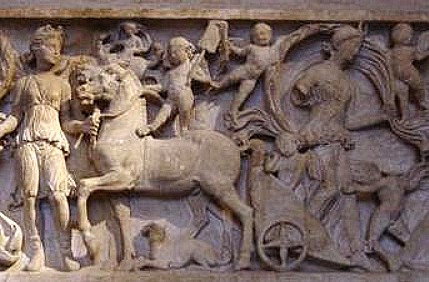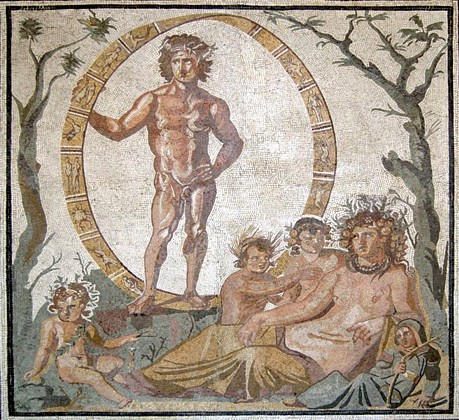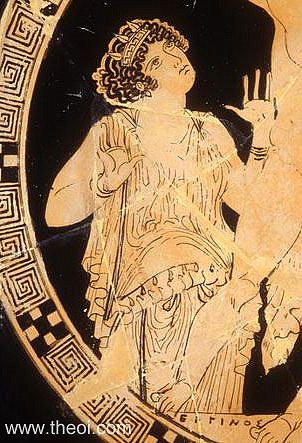Lessico
Gea - Gaia

Tellus
Mater, the Roman equivalent of Gaia, steps out of her chariot
detail of a sarcophagus in Glyptotheck in Munich
Gea o
Gaia (in greco Gê = Terra, Gaîa = Gaia) nella mitologia greca
è la divinità femminile che impersona la Terra. La Teogonia di Esiodo![]() . racconta come, dopo il Caos, sorse l’immortale
Gaia degli ampi seni, progenitrice degli dei dell’Olimpo. Da sola e senza
congiungersi con nessuno ella generò Urano (il cielo stellato), Ponto (le
sterili profondità del mare) e le colline. In seguito, racconta sempre
Esiodo, si unì a Urano dando alla luce Oceano, Ceo, Crio e i Titani Iperione,
Giapeto
. racconta come, dopo il Caos, sorse l’immortale
Gaia degli ampi seni, progenitrice degli dei dell’Olimpo. Da sola e senza
congiungersi con nessuno ella generò Urano (il cielo stellato), Ponto (le
sterili profondità del mare) e le colline. In seguito, racconta sempre
Esiodo, si unì a Urano dando alla luce Oceano, Ceo, Crio e i Titani Iperione,
Giapeto![]() , Teia, Rea, Temi, Mnemosine, Febe e Teti
, Teia, Rea, Temi, Mnemosine, Febe e Teti![]() . Dopo di loro nacque Crono
. Dopo di loro nacque Crono![]() , il più giovane furbo e terribile dei suoi figli,
che prese ad odiare il suo potente padre. Esiodo parla anche della successiva
progenie di Gaia e Urano, dapprima i Ciclopi, giganti con un solo occhio,
Bronte, Sterope e Arge. Poi i tre terribili Ecatonchiri dalle cento braccia,
Cotto, Briareo e Gige, ognuno dotato anche di cinquanta teste.
, il più giovane furbo e terribile dei suoi figli,
che prese ad odiare il suo potente padre. Esiodo parla anche della successiva
progenie di Gaia e Urano, dapprima i Ciclopi, giganti con un solo occhio,
Bronte, Sterope e Arge. Poi i tre terribili Ecatonchiri dalle cento braccia,
Cotto, Briareo e Gige, ognuno dotato anche di cinquanta teste.
Urano rinchiuse i Ciclopi e gli Ecatonchiri nel
Tartaro, in modo che non potessero vedere la luce, rallegrandosi di
quest’azione malvagia. Questo fatto fece soffrire Gaia (il Tartaro si
trovava infatti nelle sue viscere) che così creò un tipo di pietra focaia
grigia (adamantina) e con questa modellò una grande falce con cui radunò
Crono e i suoi fratelli chiedendo loro di obbedirle e aiutarla. Soltanto
Crono, il più giovane, ebbe il coraggio di prendere la falce di pietra che
lei aveva fatto e servirsene per evirare il padre quando si avvicinò a Gaia
per accoppiarsi con lei. Dalle gocce di sangue mischiato a sperma che la
colpirono Gaia generò le forti Erinni, i Giganti, tra cui Abseo, e le Ninfe
del frassino dette Melie. Il membro reciso di Urano, gettato in mare, fecondò
le acque dalla cui spuma sorse Afrodite![]() . Urano venne quindi deposto da suo figlio Crono e,
nel frattempo, i Titani liberarono i Ciclopi dal Tartaro: Crono divenne il
loro re e iniziò quella che fu chiamata l’età dell’oro. Dopo che Urano
venne castrato, Gaia ebbe anche un figlio, Tifone, dal Tartaro, mentre con
Ponto generò le divinità marine Nereo, Taumante, Forcide, Ceto ed Euribia.
. Urano venne quindi deposto da suo figlio Crono e,
nel frattempo, i Titani liberarono i Ciclopi dal Tartaro: Crono divenne il
loro re e iniziò quella che fu chiamata l’età dell’oro. Dopo che Urano
venne castrato, Gaia ebbe anche un figlio, Tifone, dal Tartaro, mentre con
Ponto generò le divinità marine Nereo, Taumante, Forcide, Ceto ed Euribia.
Alcuni studiosi credono che Gea fosse la divinità
che originariamente parlava per bocca dell’Oracolo di Delfi. Ella passò i suoi poteri, a seconda delle
versioni, a Poseidone, Apollo o Temi. Apollo![]() è il dio cui più di ogni altro è collegato
l’Oracolo di Delfi, esistente da lungo tempo già all’epoca di Omero
è il dio cui più di ogni altro è collegato
l’Oracolo di Delfi, esistente da lungo tempo già all’epoca di Omero![]() , perché in quel luogo aveva ucciso il figlio di
Gea Pitone, impossessandosi dei suoi poteri ctonici (sotterranei). Hera punì
Apollo per questo gesto inviandolo a servire per nove anni come pastore presso
il re Admeto. Nell’antica Grecia i giuramenti fatti in nome di Gea erano
considerati quelli maggiormente vincolanti.
, perché in quel luogo aveva ucciso il figlio di
Gea Pitone, impossessandosi dei suoi poteri ctonici (sotterranei). Hera punì
Apollo per questo gesto inviandolo a servire per nove anni come pastore presso
il re Admeto. Nell’antica Grecia i giuramenti fatti in nome di Gea erano
considerati quelli maggiormente vincolanti.
Nell’arte classica Gea poteva essere rappresentata in due modi diversi. Nelle decorazioni vasali ateniesi veniva ritratta come una donna dall’aspetto matronale che emergeva dalla terra soltanto per metà, spesso mentre porgeva ad Atena il piccolo Erittonio (futuro re di Atene) perché lo allevasse. Nei mosaici di epoca successiva appare come una donna che si sta stendendo a terra, circondata da un gruppo di Carpi, divinità infantili che simboleggiano i frutti della terra.

Aion
and Terra Mater (Gaia) with four children, perhaps the personified seasons
mosaic from a Roman villa in Sentinum, first half of the 3rd century BC
Munich Glyptothek - Inv. W504
Gaia ("land" or "earth", from the Ancient Greek Gaîa; also Gaea or Gê) is the primal Greek goddess personifying the Earth. Gaia is a primordial and chthonic deity in the Ancient Greek pantheon and considered a Mother Goddess or Great Goddess. Her equivalent in the Roman pantheon was Terra.
Hesiod's Theogony (116ff) tells how, after Chaos, arose broad-breasted Gaia the everlasting foundation of the gods of Olympus. She brought forth Uranus, the starry sky, her equal, to cover her, the hills, and the fruitless deep of the Sea, Pontus, "without sweet union of love," out of her own self through parthenogenesis. But afterwards, as Hesiod tells it, she lay with her son, Uranus, and bore the World-Ocean Oceanus, Coeus and Crius and the Titans Hyperion and Iapetus, Theia and Rhea, Themis, Mnemosyne, and Phoebe of the golden crown, and lovely Tethys. "After them was born Cronus the wily, youngest and most terrible of her children, and he hated his lusty sire."
Hesiod mentions Gaia's further offspring conceived with Uranus: first the giant one-eyed Cyclopes: Brontes ("thunderer"), Steropes ("lightning") and the "bright" Arges: "Strength and might and craft were in their works." Then he adds the three terrible hundred-handed sons of Earth and Heaven, the Hecatonchires: Cottus, Briareos and Gyges, each with fifty heads.
Uranus hid the Hecatonchires and the Cyclopes in Tartarus so that they would not see the light, rejoicing in this evil doing. This caused pain to Gaia (Tartarus was her bowels) so she created grey flint (or adamantine) and shaped a great flint sickle, gathering together Cronos and his brothers to ask them to obey her. Only Cronos, the youngest, had the daring to take the flint sickle she made, and castrate his father as he approached Gaia to have intercourse with her. And from the drops of blood and semen, Gaia brought forth still more progeny, the strong Erinyes and the armoured Gigantes and the ash-tree Nymphs called the Meliae.
From the testicles of Uranus in the sea came forth Aphrodite. For this, a Greek etymologist urged, Uranus called his sons "Titans," meaning "strainers" for they strained and did presumptuously a fearful deed, for which vengeance would come afterwards; for, as Uranus had been deposed by his son, Cronos, so was Cronos destined to be overthrown by Zeus, the son born to him by his sister-wife Rhea. In the meantime, the Titans released the Cyclopes from Tartarus, and Cronos was awarded the kingship among them, beginning a Golden Age.
After Uranus's castration, Gaia gave birth to Echidna and Typhon by Tartarus. By Pontus, Gaia birthed the sea-deities Nereus, Thaumas, Phorcys, Ceto, and Eurybia. Aergia, a goddess of sloth and laziness, is the daughter of Aether and Gaia. Zeus hid Elara, one of his lovers, from Hera by hiding her under the earth. His son by Elara, the giant Tityas, is therefore sometimes said to be a son of Gaia, the earth goddess, and Elara. Gaia also made Aristaeus immortal.
Gaia is believed by some sources (Joseph Fontenrose 1959 and others) to be the original deity behind the Oracle at Delphi. She passed her powers on to, depending on the source, Poseidon, Apollo or Themis. Apollo is the best-known as the oracle power behind Delphi, long established by the time of Homer, having killed Gaia's child Python there and usurped the chthonic power. Hera punished Apollo for this by sending him to King Admetus as a shepherd for nine years. Oaths sworn in the name of Gaia, in ancient Greece, were considered the most binding of all.
In classical art Gaia was represented in one of two ways. In Athenian vase painting she was shown as a matronly woman only half risen from the earth, often in the act of handing the baby Erichthonius (a future king of Athens) to Athena to foster. Later in mosaic representations she appears as a woman reclining upon the earth surrounded by a host of Carpi, infant gods of the fruits of the earth.

Attic Red Figure ca 410 - 400 BC - Antikenmuseen, Berlin, Germany
Detail of Gaia from a painting of the Gigantomakhia (War of the Giants). Gaia the earth-goddess, half risen from the earth, raises her hands to plead for the lives of her Gigante sons, who are being slaughtered in the war with the gods. The goddesss is depicted as a matronly woman, with heavy belly, full face, short curly hair, and a crown upon her head.
Interpretations
Etymologically Gaia is a compound word of two elements. Ge, meaning "Earth", is found in many neologisms, such as Geography (Ge/graphos = writing about Earth) and Geology (Ge/logos = words about the Earth). *Ge is a pre-Greek substrate word that some relate to the Sumerian Ki, also meaning Earth. Aia is a derivative of an Indo-European stem meaning "Grandmother". The full etymology of Gaia would, therefore, appear to have been "Grandmother Earth". Some sources, such as anthropologists James Mellaart, Marija Gimbutas and Barbara Walker, claim that Gaia as the Mother Earth is a later form of a pre-Indo-European Great Mother who had been venerated in Neolithic times, but this point is controversial in the academic community. Belief in a nurturing Earth Mother is often a feature of modern Neopagan "Goddess" worship, which is typically linked by practitioners of this religion to the Neolithic goddess theory.
Hesiod's separation of Rhea from Gaia was not rigorously followed, even by the Greek mythographers themselves. Modern mythographers like Karl Kerenyi or Carl A. P. Ruck and Danny Staples, as well as an earlier generation influenced by Frazer's The Golden Bough, interpret the goddesses Demeter the "mother," Persephone the "daughter" and Hecate the "crone," as understood by the Greeks, to be three aspects of a former Great Goddess, who could be identified as Rhea or as Gaia herself. Such tripartite goddesses are also a part of Celtic mythology and may stem from the Proto-Indo-Europeans. In Anatolia (modern Turkey), Rhea was known as Cybele, a goddess derived from Mesopotamian Kubau, Hurrian Kebat or Kepa. The Greeks never forgot that the Mountain Mother's ancient home was Crete, where a figure some identified with Gaia had been worshipped as Potnia Theron (the "Mistress of the Animals") or simply Potnia ("Mistress"), an appellation that could be applied in later Greek texts to Demeter, Artemis or Athena.
In Rome the imported Phrygian goddess Cybele was venerated as Magna Mater, the "Great Mother" or as Mater Nostri, "Our Mother" and identified with Roman Ceres, the grain goddess who was an approximate counterpart of Greek Demeter, but with differing aspects and venerated with a different cult. Her worship was brought to Rome following an Augury of the Cumaean Sibyl that Rome could not defeat Hannibal the Carthaginian until the worship of Cybele came to Rome. As a result she was a favoured divinity of Roman legionaries, and her worship spread from Roman military encampments and military colonies.
In other cultures
The idea that the fertile earth itself is female, nurturing mankind, was not limited to the Greco-Roman world. These traditions themselves were greatly influenced by earlier cultures in the Central area of the ancient Middle East. In Sumerian mythology Tiamat influenced Biblical notions of The Deeps in Genesis 1. The title "The mother of life" was later given to the Akkadian Goddess Kubau, and hence to Hurrian Hepa, emerging as Hebrew Eve (Heva) and Phygian Kubala (Cybele). In Norse mythology the Great Mother, the mother of Thor himself, was known as Jord, Hlódyn, or Fjörgyn. The Irish Celts worshipped Danu, whilst the Welsh Celts worshipped Dôn. Dana played an important part in Hindu mythology and hints of their names throughout Europe, such as the Don river, the Danube River, the Dnestr and Dnepr, suggest that they stemmed from an ancient Proto-Indo-European goddess. In Lithuanian mythology Gaia - Žeme is daughter of Sun and Moon. Also she is wife of Dangus (Varuna). In Pacific cultures, the Earth Mother was known under as many names and with as many attributes as cultures who revered her for example Maori whose creation myth included Papatuanuku, partner to Ranginui - the Sky Father. In South America in the Andes a cult of the Pachamama still survives (in regions of Bolivia, Peru, Ecuador, Argentina and Chile). The name comes from Pacha (Quechua for change, epoch) and Mama (mother). While ancient Mexican cultures referred to Mother Earth as Tonantzin Tlalli that means "Revered Mother Earth". In Indian religions, the Mother of all creation is called "Gayatri", a surprisingly close form of Gaia. Only in Egyptian Mythology is the reverse true - Geb is the Earth Father while Nut is the Sky Mother.
Carl Gustav Jung suggested that the archetypal mother was a part of the collective unconscious of all humans, and various Jungian students, e.g. Erich Neumann and Ernst Whitmont have argued that such mother imagery underpins many mythologies, and precedes the image of the paternal "father", in such religious systems. Such speculations help explain the universality of such mother goddess imagery around the world. The Upper Paleolithic Venus figurines have been sometimes explained as depictions of an Earth Goddess similar to Gaia.
In Neopaganism
Many Neopagans actively worship Gaia. Beliefs regarding Gaia vary, ranging from the common Wiccan belief that Gaia is the Earth (or in some cases the spiritual embodiment of the earth, or the Goddess of the Earth), to the broader Neopagan belief that Gaia is the goddess of all creation, a Mother Goddess from which all other gods spring. Gaia is sometimes thought to embody the planets and the Earth, and sometimes thought to embody the entire universe. Worship of Gaia is varied, ranging from prostration to druidic ritual.
Unlike Zeus, a roving nomad god of the open sky, Gaia was manifest in enclosed spaces: the house, the courtyard, the womb, the cave. Her sacred animals are the serpent, the lunar bull, the pig, and bees. In her hand the narcotic poppy may be transmuted to a pomegranate.
Some who worship Gaia attempt to get closer to Mother Earth by becoming unconcerned with material things and more in tune with nature. Others who worship Gaia recognize Gaia as a great goddess and practice rituals commonly associated with other forms of worship. Many sects worship Gaia, even more than worship Themis, Artemis, and Hera. Some common forms of worship may include prostration, attempting to reach a greater connection to the earth, shamanistic practices, tithing, praising and praying, creating inspired works of art dedicated to the goddess, burning oils and incense, rearing plants and gardens, the creation and maintaining of Sacred Groves. Other forms of worship may indeed be common, as worship of Gaia is very broad and can take many forms.
In modern ecological theory
The mythological name was revived in 1969 by James Lovelock, in Gaia: A New Look at Life on Earth; his Gaia hypothesis was supported by Lynn Margulis. The hypothesis proposes that living organisms and inorganic material are part of a dynamic system that shapes the Earth's biosphere, and maintains the Earth as a fit environment for life. In some Gaia theory approaches the Earth itself is viewed as an organism with self-regulatory functions. Further books by Lovelock and others popularized the Gaia Hypothesis, which was widely embraced and passed into common usage as part of the heightened awareness of planetary vulnerability of the 1990s.
In Literature
Gaia (Gaea) is referenced through the re-naming of a character in Ayn Rand's science fiction novella, "Anthem." Gaia, a preternaturally beautiful and highly skilled teenaged girl born without the fear gene, is also the protagonist of Francine Pascal's young adult series, "Fearless." Gaia is described as the Earth Mother and aids the protagonists in Chris D' Lacey's The Fire Within series. She takes on many animal forms, such as an albino hedgehog (dubbed 'Spikey') and the legendary mate of one of the seven bears that ruled the ice, Sunasala.